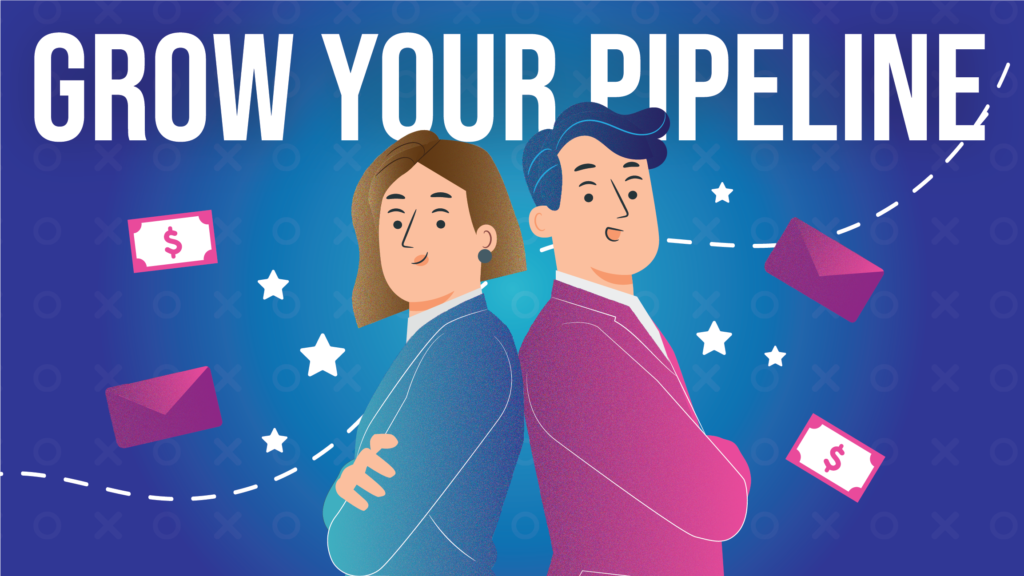
Ever happened to you?
You sat at your desk in the morning, coffee in hand, and… resigned, just cursed under your breath.
- You’ve been sending emails to prospects but no one’s budging.
- You tried calling them then and left a ton of voicemails. But the result is always the same.
And now, you’re out of ideas on what to do next.
You feel done.
I don’t want to be the bearer of bad news, but here’s a hard truth about prospecting – It works. It works so incredibly well… with a plan.
When you have a strong sales cadence, you know exactly how to follow up with a prospect and when. (Not to mention that you can also automate part of this process.)
But without it, you’re bound to hit a wall sooner or later.
The problem? It’s hard to define a sales cadence if you don’t know what it should look like in the first place.
Hence this guide. Below, you’ll discover 5 sales cadence examples that will a.) show you the elements of such cadence in practice and b.) help you realize how to plan a cadence for yourself.
Intrigued? Let’s take it from the top, then.
What exactly is a sales cadence?
The term – sales cadence – refers to a repeatable process that you follow when connecting with prospects to engage them and kickstart a sales conversation.
Typically, such a cadence is a part of an outbound sales strategy. However, as you’ll see later in this guide, you can define cadences to help you engage inbound leads too.
In practical terms, a strong sales cadence lists all touchpoints with a prospect and their sequence. It covers what you need to do from the first introductory email through your typical email outreach sequence, phone calls, and other messages you leave for them.
But the key phrase in this definition is “repeatable.”
You see, a sales cadence’s purpose is to give you a roadmap and a plan that you can follow without having to think about your next steps.
Here’s an example of a typical sales cadence. Note how it outlines when to engage a prospect and with what message. It leaves very little to chance and defines every touchpoint.
It’s a process that you can run continuously.
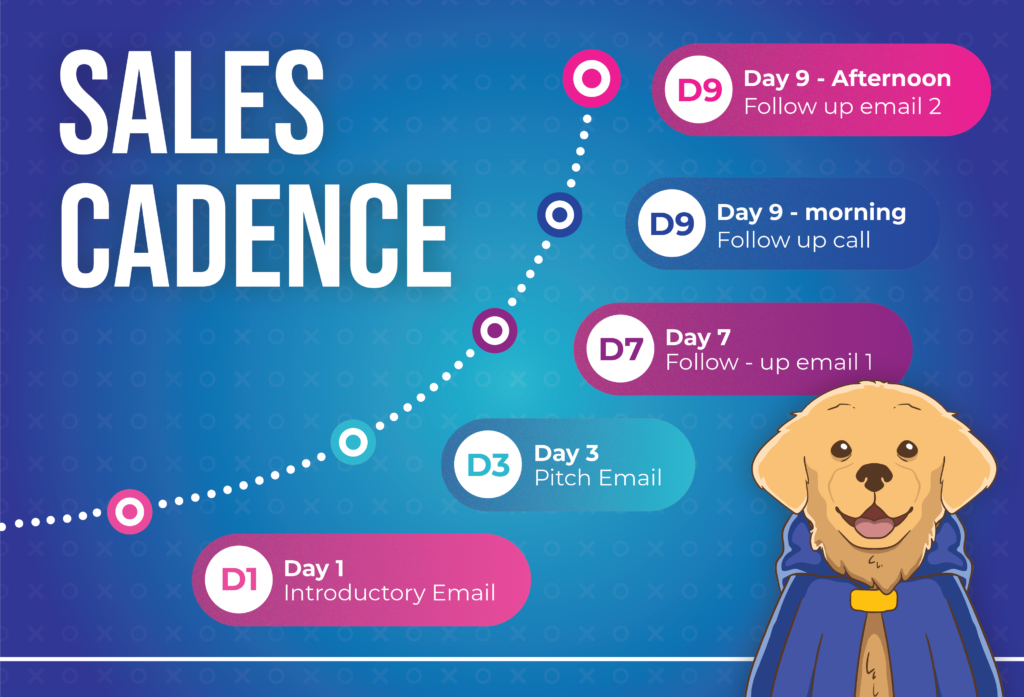
But that’s also what makes developing a sales cadence so challenging.
You see, you need to create it so that it could use for every prospect and deliver results.
(A quick side note – There is a way to make the task a little easier. You can do it by developing different sales cadences for various scenarios or prospect types. Later in this guide, you will see examples of just that – sales cadences designed for different sales scenarios.)
Let’s quickly review what goes into a typical sales cadence.
How to Create a Sales Cadence – The 5 Elements of a Sales Cadence
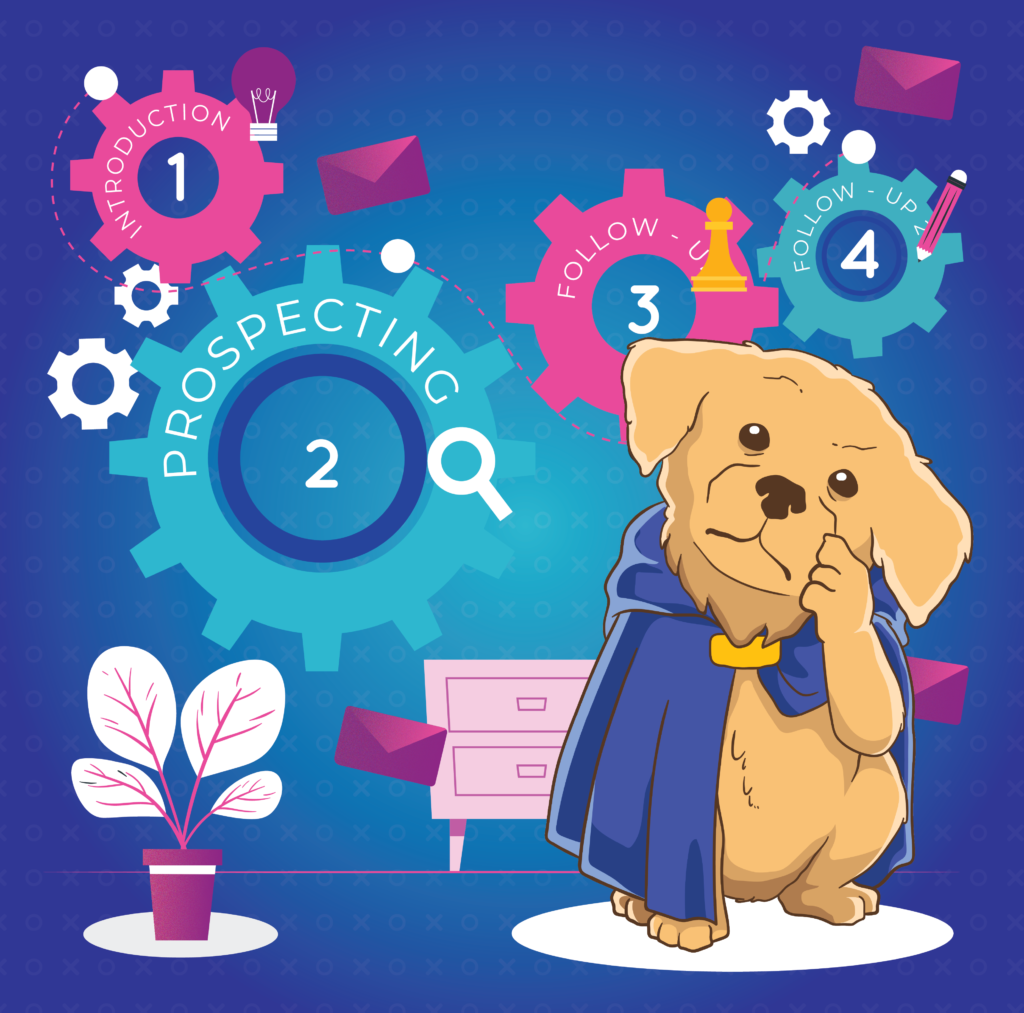
There are five individual elements that you must define when creating one.
#1. The target audience
I know – This is so obvious.
Then again, one reason why many sales reps struggle with developing sales cadences is that they don’t understand the people they’re trying to reach.
Look at people like me – SaaS founders. Imagine you’re trying to reach one of us – a progressive bunch. We work with the latest technologies and utilize them in our daily lives.
So, there’s no point in finding our office phone numbers. Most of us don’t have one (just like we don’t have offices either.) And even if someone did, they’d usually be out and about most of the time.
But we’re active on email. And many of us would log in to LinkedIn regularly too.
As a result, these should be your primary channels of communication with us, right?
Well, here’s the thing – You can know something like that only by researching and understanding your target audience, how they communicate, how they spend their days at work, and so on.
#2. Communication channels
Look – There is no universal rule for how many channels to use or which ones to focus on.
I’ve already illustrated that in the previous section.
I believe that a strong sales cadence should include at least two communication channels. But, of course, in the case of some audiences, you might need more than that.
The most common channels for sales cadences include email, phone, LinkedIn (and other social media channels,) voicemail, text messages, and more.
You can include practically any channel that would help you reach out to prospects here.
The key is to focus on channels or platforms your prospects are most likely to use. Also, monitor your cadences to see if specific channels generate higher engagement than others.
(NOTE – Later in this guide, I’ll also show you what KPIs to use when monitoring the performance of your sales cadence.)
#3. Cadence length
I admit that this is another problematic element to define. Because how could you even know how many touchpoints you’d need to engage a prospect without engaging them first?
The good news is that we can turn to data for help.
For example, we already know that, on average, prospects need to hear from you at least seven times before making a purchase.
At the same time, another research finding discovered that most prospects stop engaging with sales messages after the 12th touchpoint.
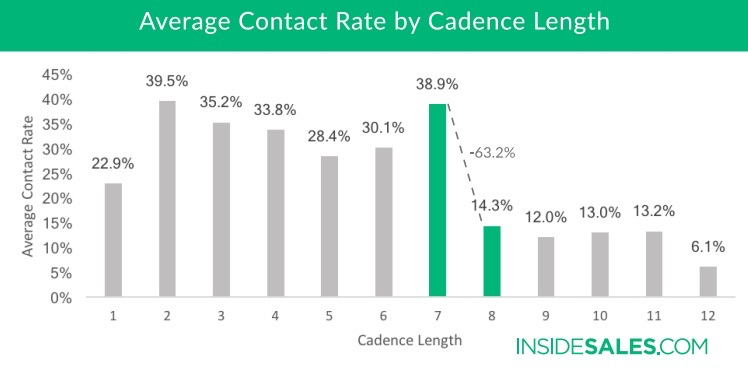
What’s more, as you can see from the above graph, the likelihood of a person replying to your message drops dramatically after the 7th touchpoint.
This doesn’t suggest that your cadence must be seven steps or shorter. But it suggests that this sales cycle shouldn’t contain more than 7-12 touchpoints.
#4. Timing
Cadence timing defines intervals between those touchpoints.
Again, there is no universal approach here. Overall, however, sending messages too often will likely only irritate the prospect.
At the same time, sending them too far apart may make them forget about you.
The only way to discover the ideal timing is by testing different options and measuring results.
This brings us to the final element of a sales cadence…
#5. Measuring performance
Did you notice?
Practically every time I described an aspect of a sales cadence, I had to say this:
“There is no one-size-fits-all approach to…”
That’s the unfortunate thing about sales cadences – There is no universal approach guaranteed to work every single time.
(NOTE – That’s also why I’m telling you all this instead of just showing you those sales cadence examples I promised. That’s because they are just that, examples. You might need to experiment and customize them to your target audience, product, etc., and this advice will ensure that you know how.)
And that’s why it helps to monitor campaign performance with relevant KPIs (key progress indicators.)
Identify KPIs that report whether the campaign is working – for example, your conversion rate is healthy and improving. Monitor them regularly to see whether the campaign is improving or losing momentum.
TIP: Sales outreach tools typically feature a reporting dashboard showing you various metrics about your campaign. Here’s an example of what such a dashboard looks like in Postaga.
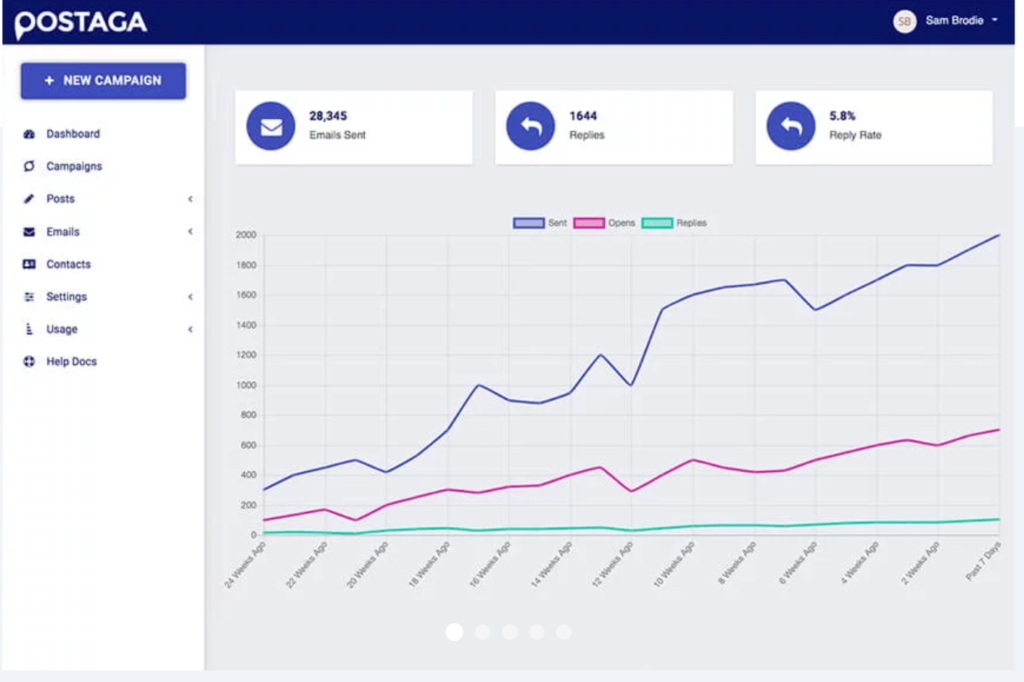
But that’s enough theory, I think… So let’s review those sales cadence examples now.
5 Winning Sales Cadence Examples

Below, you’ll find five different sales cadences.
Each focuses on a different use case and shows what touchpoints to include and the timing of those messages.
Use these examples to understand sales cadences, modify them, and include them in your sales plan.
So, let’s do it.
#1. Fast-paced sales cadence example
Touchpoints: 7
Length: 10 days
Disclaimer: This amazing cadence was first suggested by Max Altschuler, CEO of Sales Hub.
It is perfect to use if you want to achieve results from your sales outreach fast. It’s short, includes only a handful of touch points, and uses 2-3 channels only (email and phone.) That said, you could substitute some email messages with LinkedIn InMail, for example.
That said, for some prospects, sending messages so soon one after another and following up with phone calls might feel too aggressive. So, use this sales cadence cautiously.
Max suggests structuring a cadence like this:
Day 1: Introductory email – A personalized message to introduce yourself to the prospect.
Day 3: Prospecting email – Dive further into your offering and deliver value to a prospect
Day 5: Follow-up call in the morning and another one in the afternoon.
Day 7: Follow-up email in the morning, follow-up call in the afternoon
Day 10: Follow-up email and call in the morning.
#2. B2B sales cadence example
Touchpoints: 8
Length: 2 weeks+
This is a longer sales cadence that is ideal for B2B sales. It can help you engage a prospect, set an appointment, or move the person/company further down your sales funnel.
Day 1: Introductory email
Day 3: Pitch email
Day 7: Follow-up email 1
Day 9: Follow-up call in the morning, follow-up email 2 in the afternoon.
Day 12: Follow-up email 3
Day 14: Follow-up email 4
Day 18: Break-up email
#3. Longer B2B sales cadence example
Touchpoints: 10
Length: 6 months+
The previous B2B sales cadence ended with a definite break-up email. Sometimes, sending one is the only way to elicit a response from a prospect. But, unfortunately, you also risk they won’t reply, and you will ultimately end the cadence with them for good.
Here’s a variation of that cadence that leaves the tail end open, so you can either keep following up or restart the cadence after a lengthy break.
Day 1: Introductory cold email
Day 2/3: Introductory cold call
Day 5: Follow-up email 1 or follow-up phone call (It’s fine to leave the prospect a voicemail message at this stage too.)
Day 10: Follow-up email 2
Day 17: Follow-up email 3
Day 25/30: Follow-up email 4
Day 50/60: Follow-up phone call
3+ months: Follow-up email restating the introduction and the value of the first email.
6+ months: Follow-up email or phone call.
NOTE – Since this campaign does not end with a break-up email, you could, theoretically, keep following up in infinity. However, I’d recommend closing the campaign after the 6-month follow-up and restarting it after a lengthier gap.
#4. Inbound sales cadence example
Touchpoints: 9
Length: 30+ days
Getting an inbound inquiry feels amazing. But even though someone reached out, it doesn’t mean that they will respond to your responses.
Often, you need to follow up with those prospects several times too, and this is an example cadence to use.
Because the prospect reached out and initiated the engagement, you can go through the sequence faster and continue it for longer.
Also, note that in the case of inbound lead follow-up, the channel you use is secondary. Whether you follow up with email or by calling depends more on your inbound process than anything else. You can also mix and match both approaches throughout the cadence.
Day 1: Initial response to the inbound inquiry. Depending on your business, you can respond by email or phone.
Day 2: Follow-up 1 (email or phone, depending on your preference and the inbound sales process.)
Day 4: Follow-up 2 (email or phone)
Day 6: Follow-up 3 (email or phone)
Day 10: Follow-up 4 (email or phone)
Day 14: Follow-up 5 (email or phone)
Day 20: Follow-up 6 (email or phone)
Day 30: Follow-up 7 (email or phone)
2+ months: Follow-up 3 (email or phone)
#5. A more complex inbound sales cadence
Touchpoints: 9
Length: 1 month
Use this cadence if you’re not entirely comfortable just emailing or calling the prospect. It diversifies your channels and is more aligned with B2B sales processes.
Day 1: Initial response to the inquiry (email or phone)
Day 2: Email restating the value proposition of the solution the prospect inquired about
Day 4: Email follow-up 1 or phone follow-up 1
Day 6: Email follow-up 2
Day 10: Phone follow-up 2
Day 14: LinkedIn outreach
Day 20: Email follow-up 3 or phone follow-up 3
Day 30: Email follow-up 4
1+ month: Break-up email
And that’s it…
Now you know what a solid sales cadence looks like. You also have the information you need to create one for your sales team.
All that’s left is to start planning and building your outreach cadences.
Good luck!
Free 14-Day Trial
Start building relationships now with your fully-featured 14-day trial!
How We Compare
Terms | Done-For-You Terms | Privacy | Write For Us | Press
© 2024 Postaga. All Rights Reserved. Made with 
